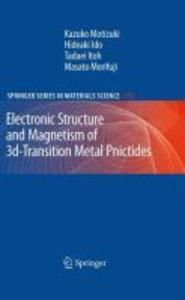This book describes in 2 parts experimental data with simple explanations (Part I) and itinerant electron theories (Part II) about magnetism and its related properties of 3d-intermetallic compounds. Unlike 3d-metal alloys and oxides, theoretical as well as experimental studies on 3d-intermetallic compounds such as 3d-pnictides and chalcogenides, on which we focus in this book, seem unfortunately delayed. The objective of this book is to motivate active studies in this ? eld in the future. We discuss in detail magnetic and related properties of the 3d-transition-metal pnictides and chalcogenides, which include the intermetallic compounds expressed as MX and M X, and their mixed compoundsM M X, MX X and M M X, 2 1? x x 1? y 2? x y x where M (M)isa3d element and X (X ) a pnicogen (P, As, Sb, and Bi) or a chalcogen (S, Se, and Te). Most of the MX-type compounds crystallize either in the hexagonalNiAs-type structure or in the orthorhombicMnP-type structure which is regarded as a distorted NiAs-type structure. Crystallographic phase transition b- ween the NiAs- and the MnP-typesoccursin some of MX-typecompoundswhen the temperaturechanges. The M X-type compoundscrystallize in the tetragonalCu Sb- 2 2 typestructure. Asdescribedin detailinthisbook, manyofthecompoundsmentioned aboveexhibitveryinterestingmagneticandcrystallographicphasetransitionscaused by various means such as change of temperature, applications of external magnetic ? eld or pressure, and change of the composition x in the case of mixed compounds.
Inhaltsverzeichnis
Experimental. - Basic Properties of 3-Pnictides. - Overview of Magnetic Properties of NiAs-Type (MnP-Type) and CuSb-Type Compounds. - Properties of the Compounds with NiAs-Type (MnP-Type) and CuSb-Type Structures. - Itinerant Electron Theory. - Electronic Band Structure and Magnetism of NiAs-Type Compounds. - Itinerant Electron Theory of Magnetism of CuSb-Type Compounds.













